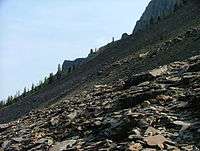Mount Stephen trilobite beds
| Part of a series on |
| The Burgess Shale |
|---|
 |
|
Geology and localities
|
|
Evolutionary concepts |
The Mount Stephen trilobite beds (UNSM locality 14s)[1] are a series of fossil strata on Mount Stephen, British Columbia that contain exceptionally preserved fossil material. Part of the same stratigraphic unit as the Burgess Shale, many non-mineralized parts (such as anomalocarid claws, sponges, and trilobite legs) are preserved; in addition, a high density of trilobite fossils is present.
History


The trilobite beds were the first Burgess shale locality to be discovered.[2]
The richness of fossils in the Field area was first identified by workers associated with the construction of the Trans-Canada railway, which had (somewhat controversially) been routed through the Kicking Horse valley.[3] Richard McConnell, of the Geological Survey of Canada, was pointed to the beds by a railway worker whilst mapping the geology around the railway line in September 1886.[4] Several unusual fossils were subsequently described from this site, including sponges, worms,[5] and the appendages of the unusual Anomalocaris, identified at that time as the bodies of crabs.[6] These fossils prompted Charles Doolittle Walcott to make forays into the area, and led to his discovery of the Walcott Quarry on Fossil Ridge.
Stratigraphy
The trilobite beds are in the Campsite Cliff member, and contain the marker trilobite Ogygopsis.[7]
Location

References
- ↑ Conway Morris, Simon; Robson, R.A. (1988). "More soft-bodied animals and algae from the Middle Cambrian of Utah and British Columbia." (PDF). University of Kansas Paleontological Contributions 122: 1–48.
- ↑ Collins, D. (July 1, 2009). "A Brief History of Field Research on the Burgess Shale". In Caron, Jean-Bernard; Rudkin, David. A Burgess Shale Primer—History, Geology and Research Highlights. The Burgess Shale Consortium. pp. 15–32. ISBN 978-0-9812885-0-5.
- ↑ Collins, Desmond (August 2009). "The Discovery of the Burgess Shale Site on Fossil Ridge, British Columbia" (PDF). In Smith, Martin R.; O'Brien, Lorna J.; Caron, Jean-Bernard. Abstract Volume. International Conference on the Cambrian Explosion (Walcott 2009). Toronto, Ontario, Canada: The Burgess Shale Consortium (published 31 July 2009). ISBN 978-0-9812885-1-2.
- ↑ Collins, D. (Aug 2009). "Misadventures in the Burgess Shale". Nature 460 (7258): 952–953. Bibcode:2009Natur.460..952C. doi:10.1038/460952a. ISSN 0028-0836. PMID 19693066.
- ↑ Matthew, G.F. (1899). "Studies on Cambrian Faunas, No. 3.—Upper Cambrian Fauna, Mount Stephen, British Columbia.—The Trilobites and Worms". Transactions of the Royal Society 5: 39–68.
- ↑ Whiteaves, J.F. (October 1892). "Description of a new genus and species of Phyllocarid crustacean from the Middle Cambrian of Mount Stephen, B.C.". The Canadian Record of Science 5 (4).
- ↑ Caron, J.-B.; Scheltema, A.; Schander, C.; Rudkin, D. (2006). "A soft-bodied mollusc with radula from the Middle Cambrian Burgess Shale" (PDF). Nature 442 (7099): 159–163. Bibcode:2006Natur.442..159C. doi:10.1038/nature04894. PMID 16838013.